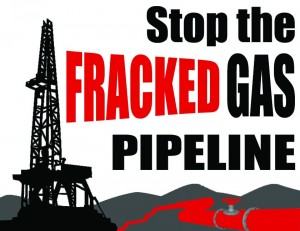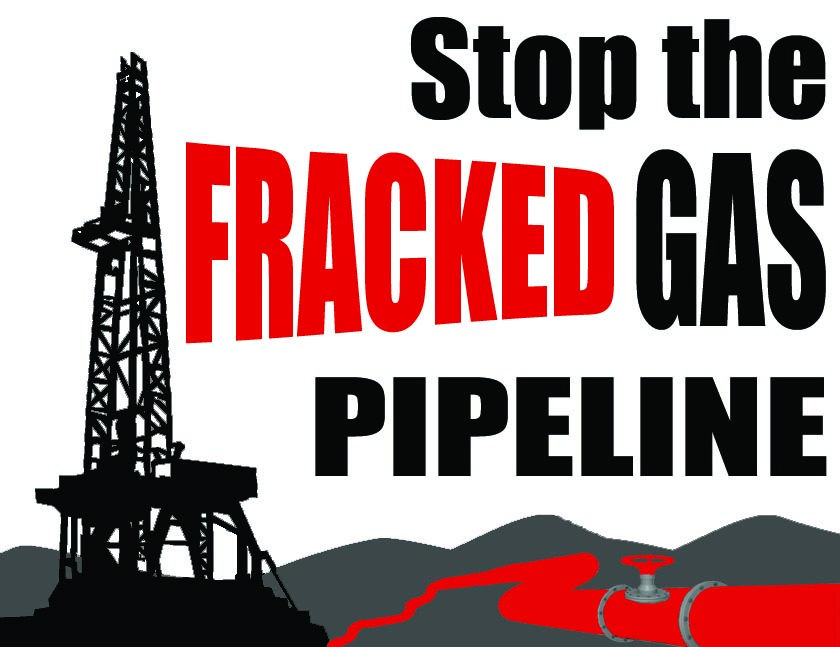The Federal Energy Regulatory Commission (FERC) took the next, and almost final, step required to force through Spectra Energy’s AIM project Friday. If approved, it would expand pipelines and compressor stations needed to transport fracked-gas from the Marcellus Shale in Pennsylvania to New England.
FERC admits that the proposed project will have “some adverse environmental impacts” but it is of the opinion that most of these would be reduced to “less-than-significant” by minor changes to the original plan, FERC wrote, with a toxic brew of acronyms and legal jargon designed to be impenetrable by the average reader in its Final Environmental Impact Statement (FEIS).

I admit that wrecking the global climate and exposing humanity to the risk of wiping out a couple of billion people is highly suggestive of an “adverse environmental impact.” The support offered for the opinion that minor changes would reduce this problem to “less-than-significant” is less-than-convincing.
To put the FEIS in perspective, let me recall some background information. Fracked gas is an essential component of the President’s Climate Action Plan – aka all-of-the-above. It provides the fossil fuel industry with cover for enterprises like the AIM project.
James Hansen, former head of NASA’s Goddard Institute for Space Studies, submitted an amicus science brief in a lawsuit brought against the U.S. government:
[U]nabated fossil fuel emissions continue to drive the Earth increasingly out of energy balance. Unless action is undertaken without further delay … Earth’s climate system will be pressed toward and past points of no return … [D]elay in undertaking sharp reductions in emissions will undermine any realistic chance of preserving a habitable climate system.
The bracketed edits are by Mary Christina Wood in her book Nature’s Trust. For more on Hansen’s work this see this short version of a paper, or this long version of the same.
Another important piece of background information is the contained in a video clip from Gassland 2 in which Robert Howarth explains the results of a series of scientific studies:
HOWARTH: The hypothesis here is that shale [fracked] gas is better for global warming than other fossil fuels and it’s a good transitional fuel. We tested that and the answer is: “No, it’s not!” The Whitehouse has clearly bought into this idea that natural gas is part of the solution of moving us gradually off of fossil fuels. I don’t think that they did that with good science.
The result of a convincing study of the effects of fracked gas on the climate is that
… both shale [fracked] gas and conventional natural gas have a larger GHG [greenhouse gas footprint] than do coal or oil, for any possible use …
a quote from a peer reviewed paper A bridge to nowhere: methane emissions and the greenhouse gas footprint of natural gas.
With this in mind, deconstructing the FEIS requires only common sense. The conclusion is that our lawmakers fail in their fiduciary duty to cherish and protect the Earth —water, land and air— for current and coming generations.
This is my “favorite” part of the FEIS (see page I-5); you won’t miss a thing if you only read what I highlighted, but I’m including the whole paragraph for lovers of bureaucratic hogwash:
Commentors also noted that the EIS should address the indirect impacts of induced Marcellus shale development. Impacts that may result from additional shale gas development are not “reasonably foreseeable” as defined by the Council on Environmental Quality (CEQ) regulations. Nor is such additional development, or any correlative potential impacts, an “effect” of the Project, as contemplated by the CEQ regulations, for purposes of a cumulative impact analysis. The development of the Marcellus shale, which is regulated by the states, continues to drive the need for takeaway interstate pipeline capacity to allow the gas to reach markets. Therefore, companies are planning and building interstate transmission facilities in response to this new source of gas supply. In addition, many production facilities have already been permitted and/or constructed in the region, creating a network through which natural gas may flow along various pathways to local users or the interstate pipeline system, including Algonquin’s existing system. Algonquin would receive natural gas through its interconnection with other natural gas pipelines. These interconnecting pipeline systems span multiple states with shale formations in the northeast, as well as conventional gas formations. We cannot estimate how much of the Project volumes would come from current/existing shale gas production and how much, if any, would be new production “attributable” to the Project.
Take the phrase: “not ‘reasonably foreseeable’ as defined.” Of course, it is perfectly clear that we have a problem: we’re importing gas to Rhode Island and exporting death and destruction to Pennsylvania and to the globe as a whole and we are causing health problems for the people living in the vicinity of the pipelines. Might there be a reason why the pipeline does not run through Watch Hill? No worries! The problem has been defined out of existence by laws written by lobbyists in exchange for campaign contributions. The law is an ass; you can ride it wherever you like, but it usually delivers for the ruling class.
Then there is is the phase “[w]e cannot estimate.” Clearly, our system of government has reversed the burden of the proof: pollution is just fine until the People prove that it’s not. Nobody seems to notice that this runs contrary to the original intent of the Clean Air and Clean Water acts.
There is more of this in the next paragraph, also from page I-5 with my bold:
We also note that the EPA and the states have imposed regulations within the past 2 to 3 years on natural gas production to minimize leaks and methane emissions. Therefore, past studies on production leaks and methane emissions cannot be used to appropriately predict future methane emissions. Predicting methane emissions and associated climate impacts is speculative given the newly required minimization efforts.
Again, the burden of the proof has been reversed. There is no evidence that the fugitive methane problems can be solved; all we have is the “yes we can” from the likes of Halliburton.
Tony Ingraffea explains the problem of methane emissions in this video:
Let me summarize it. There are numerous workshops and conferences, and countless papers on “well-bore integrity” for a simple reason: wellheads leak and nobody knows how to fix it. EPA and FERC act as if they have super-natural powers: “We impose regulations; nature know who’s the boss; problem solved!” I also wonder, if past studies cannot be used to make predictions, how does FERC predict the impact of what it’s approving? Once again, in case of doubt, the corporate stakeholders win.
The next paragraph of the FEIS talks about “improper segmentation.” Let me explain what that means: chop the project into several segments and build the first one under different, national regulations. That has the additional advantage that you’re working with New England senators and governors whose main concern, as we know, is to keep the poor in New England warm. Most importantly, you to never have to evaluate the cumulative impact of all the segments that you incrementally ram down the People’s throat.
FERC has yet another half-assed argument to show that improper segmentation is not a problem for the AIM Project. I’ll spare you the gobbledygook; it’s again on page I-5 of the FEIS. Let me just mention that the price of natural gas on the world market was probably three of four times as high as the national fracked-gas price when the AIM Project was hatched, but we are supposed to have forgotten that.
FERC goes by statutory law written by polluters for polluters. Here is The Trillion-Gallon Loophole: Lax Rules for Drillers that Inject Pollutants Into the Earth, yet another case that strengthens me in my conviction that:
- There has been a corporate takeover of government. We have to step up street protests, blockades, civil resistance, and direct action in general. This will become increasingly more difficult as the proposed law to make blocking roads in RI a felony demonstrates: the ruling class is waking up to the reality that the party is over and they are fighting back.
- The fracking ban in NY (see this press release) goes a long way toward putting the burden of the proof where it belongs. The NY argument is essentially that not enough is known to proceed with fracking and that what is known does not bode well. That indeed suffices to warrant a ban.
- For failing to fulfill its fiduciary duty to protect the environment and Nature’s Trust of which this office is a trustee, we should file a lawsuit against the Governor of Rhode Island. We should name our congressional delegation as co-defendants. In other words, let’s join the Atmospheric Trust Litigation movement!
This last point deserves a fuller explanation. For that see this video or better yet read Mary Christine Wood’s book: Nature’s Trust.

